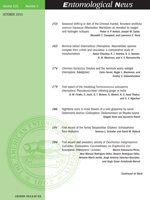Praying mantids are widely distributed apex predators within arthropod assemblages. To determine the variable ontogenetic impact of these predators, we measured the stable isotopes of oxygen (δ18O) and hydrogen (δD) in Chinese praying mantids Tenodera aridifolia sinensis (Saussure) and their dietary inputs throughout a growing season in both the laboratory and field. The δD of mantids raised in the laboratory was relative to the signatures of the prey they consumed, but δ18O values varied widely. Field-caught mantids exhibited a discernible seasonal trend in hydrogen enrichment and oxygen depletion. The δD values exhibit a steady increase throughout the subsequent instars, providing further support to the idea that instead of acting as frequency-dependent predators, mantids shift their diet throughout the season as they grow and mature. This work supports using hydrogen isotope analyses in food web studies and suggests that community impacts of generalist predators are strongly influenced by seasonality.
How to translate text using browser tools
15 October 2015
Seasonal Shifting in Diet of the Chinese Mantid, Tenodera aridifolia sinensis Saussure (Mantodea: Mantidae) as Revealed by Oxygen and Hydrogen Isotopes
Pieter A. P. deHart,
Joseph M. Taylor,
Meredith C. Campbell,
Lawrence E. Hurd
ACCESS THE FULL ARTICLE

Entomological News
Vol. 125 • No. 3
October 2015
Vol. 125 • No. 3
October 2015
apex predators
deuterium
generalist predators
oxygen
Praying mantids
stable isotopes




